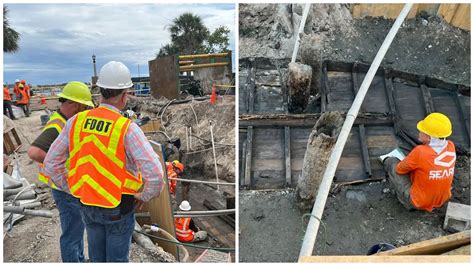
Construction workers in Valencia, Spain, have unearthed a remarkable archaeological find: six well-preserved ancient shipwrecks dating back to the Roman era and potentially earlier, discovered during the expansion of an urban area. The unexpected discovery, hailed as a significant historical event, has paused construction as archaeologists meticulously excavate and document the vessels, promising to shed new light on ancient maritime trade and shipbuilding techniques.
The discovery occurred during infrastructure work intended to expand an urban area in Valencia. “Construction workers discovered not one, but six ancient shipwrecks,” reported Yahoo News, underscoring the scale of the find. The ships are believed to originate from the Roman period, with possibilities of some predating it, making them invaluable resources for understanding ancient Mediterranean maritime activities.
Archaeologists are currently on-site, carefully extracting the shipwrecks and ensuring that each vessel is properly documented. The excavation process is complex and time-consuming, as the artifacts are fragile and require careful handling to prevent damage. Preliminary assessments suggest that the ships were used for trade and commerce, indicating Valencia’s vital role as a trading hub in ancient times.
“This is an unprecedented discovery,” stated Dr. Helena Bonet, the lead archaeologist overseeing the excavation. “The preservation of these ships is remarkable, and they promise to tell us so much about the maritime history of this region.” The ships’ condition and the context in which they were found offer a unique opportunity to study ancient shipbuilding methods, trade routes, and the daily lives of seafarers.
The shipwrecks vary in size and design, reflecting different periods and purposes. Some appear to have been smaller coastal vessels, while others were larger ships capable of traversing longer distances. The diversity among the vessels highlights the breadth of maritime activity that once thrived in this region.
The discovery has generated significant excitement among historians and archaeologists worldwide. Experts believe that the ships can provide invaluable insights into the economic, social, and technological aspects of ancient Mediterranean societies. The artifacts recovered from the shipwrecks, including pottery, tools, and personal belongings, will further enrich our understanding of the past.
The Valencian government has pledged its full support for the excavation and preservation efforts. Plans are underway to establish a dedicated museum or research center to showcase the shipwrecks and related artifacts. This initiative aims to ensure that the public can appreciate and learn from this extraordinary archaeological find.
The construction project has been temporarily halted to allow archaeologists to complete their work. While this delay may pose challenges for the development plans, authorities recognize the immense historical value of the shipwrecks and are committed to prioritizing their preservation. The discovery underscores the importance of archaeological assessments during construction projects, particularly in historically significant areas.
The excavation is expected to continue for several months, and researchers anticipate uncovering more artifacts and information as they delve deeper into the site. The shipwrecks will be carefully analyzed and documented, and their findings will be published in academic journals and presented at conferences.
The discovery of these six ancient shipwrecks in Valencia is a testament to the region’s rich maritime history and its significance as a crossroads of cultures and trade in the ancient world. The meticulous excavation and study of these vessels will undoubtedly enhance our understanding of the past and provide valuable insights into the lives and achievements of those who sailed the Mediterranean centuries ago.
In-Depth Analysis
The unearthing of six ancient shipwrecks during a construction project in Valencia is more than just a historical find; it’s a profound archaeological event that offers an unprecedented window into the maritime activities of the ancient Mediterranean world. The significance of this discovery extends beyond the mere recovery of historical artifacts; it provides a unique opportunity to reconstruct the economic, social, and technological landscape of the Roman period and potentially earlier eras.
Contextual Background
Valencia, located on the eastern coast of Spain, has long been a strategically important port city. Its geographical position made it a vital hub for trade and communication between the eastern and western Mediterranean. Throughout history, various civilizations, including the Romans, Visigoths, and Moors, have occupied and influenced the region, leaving behind a rich tapestry of cultural and historical heritage.
The discovery of the shipwrecks underscores Valencia’s role as a key maritime center in ancient times. The vessels, believed to have been involved in trade and commerce, provide tangible evidence of the city’s economic importance. They also offer insights into the types of goods that were traded, the routes that were used, and the technological capabilities of ancient shipbuilders.
Archaeological Significance
The preservation of the shipwrecks is particularly remarkable, as organic materials such as wood tend to degrade over time. The fact that these ships have survived for centuries, buried beneath the earth, is a testament to the specific environmental conditions of the site. The anaerobic environment (lack of oxygen) likely played a crucial role in preventing the decomposition of the wood.
The archaeological excavation of the shipwrecks is a painstaking process that requires specialized expertise and meticulous attention to detail. Archaeologists must carefully remove the surrounding soil and sediment, document the position and orientation of each vessel, and record any associated artifacts. The recovered artifacts, such as pottery, tools, and personal belongings, are then analyzed to provide further insights into the lives of the people who used the ships.
Potential Insights
The study of the shipwrecks has the potential to yield valuable information about various aspects of ancient maritime history, including:
- Shipbuilding Techniques: The design and construction of the ships can reveal the technological capabilities of ancient shipbuilders. By examining the materials used, the methods of joinery, and the overall structure of the vessels, archaeologists can gain a better understanding of how these ships were built and how they functioned.
- Trade Routes: The types of goods found on board the ships can provide clues about the trade routes that were used. By analyzing the provenance of the artifacts, archaeologists can trace the origins of the goods and identify the regions with which Valencia was trading.
- Economic Activities: The types of goods being transported can also shed light on the economic activities that were prevalent in Valencia and the surrounding region. For example, the presence of agricultural products might indicate that Valencia was a major agricultural center, while the presence of manufactured goods might suggest that the city was also a center of industry.
- Social and Cultural Life: The personal belongings found on board the ships can provide insights into the lives of the people who sailed them. Items such as clothing, jewelry, and religious artifacts can reveal details about their social status, cultural beliefs, and daily routines.
- Maritime Technology: The discovery can offer insights into the evolution of maritime technology, navigation techniques, and the challenges faced by ancient seafarers.
Preservation and Conservation
The preservation and conservation of the shipwrecks are of paramount importance. Once the ships have been excavated, they must be carefully treated to prevent further deterioration. This typically involves cleaning, stabilizing, and consolidating the wood to ensure that it does not crumble or decay.
The long-term preservation of the shipwrecks may involve storing them in a controlled environment, such as a museum or research facility. Alternatively, some or all of the ships may be reconstructed and displayed to the public. The decision of how to preserve and display the shipwrecks will depend on a variety of factors, including the condition of the vessels, the available resources, and the goals of the preservation effort.
Impact on the Local Community
The discovery of the shipwrecks has had a significant impact on the local community in Valencia. The construction project has been temporarily halted, and the area has been transformed into an archaeological site. While this has caused some disruption, it has also generated a great deal of excitement and interest in the city’s history.
The local government has pledged its full support for the excavation and preservation efforts. Plans are underway to establish a dedicated museum or research center to showcase the shipwrecks and related artifacts. This initiative aims to ensure that the public can appreciate and learn from this extraordinary archaeological find. The discovery is expected to boost tourism and enhance Valencia’s reputation as a city with a rich historical heritage.
Challenges and Future Research
The excavation and study of the shipwrecks present several challenges. The fragile nature of the artifacts requires careful handling and specialized expertise. The sheer scale of the discovery means that the excavation process will be time-consuming and expensive. Furthermore, the interpretation of the archaeological evidence will require collaboration between experts from various disciplines, including archaeology, history, maritime studies, and conservation.
Future research efforts will focus on analyzing the shipwrecks and the associated artifacts in detail. This will involve conducting scientific tests, such as radiocarbon dating and DNA analysis, to determine the age and origin of the materials. It will also involve comparing the shipwrecks with other known examples of ancient vessels to identify similarities and differences.
The ultimate goal of the research is to reconstruct the history of the shipwrecks and to understand their significance in the context of ancient Mediterranean maritime history. The findings will be published in academic journals and presented at conferences, ensuring that the knowledge gained from this discovery is shared with the wider world.
The discovery of these six ancient shipwrecks is a momentous event that promises to transform our understanding of ancient maritime history. The meticulous excavation and study of these vessels will undoubtedly yield valuable insights into the lives and achievements of those who sailed the Mediterranean centuries ago. The find serves as a reminder of the importance of preserving our historical heritage and of the potential for archaeological discoveries to shed new light on the past.
Quotes:
- “Construction workers discovered not one, but six ancient shipwrecks.”
- “This is an unprecedented discovery. The preservation of these ships is remarkable, and they promise to tell us so much about the maritime history of this region.” – Dr. Helena Bonet
FAQ Section
1. Where were the shipwrecks discovered?
The shipwrecks were discovered in Valencia, Spain, during construction work intended to expand an urban area. The site is located near the city’s port.
2. How old are the shipwrecks believed to be?
The shipwrecks are believed to date back to the Roman period and potentially even earlier. This makes them several centuries old and highly significant for understanding ancient maritime history.
3. What kind of ships were discovered?
The ships vary in size and design, suggesting different purposes. Some appear to have been smaller coastal vessels, while others were larger ships capable of traversing longer distances, likely used for trade and commerce.
4. What will happen to the shipwrecks now?
The shipwrecks are currently being excavated and documented by archaeologists. After excavation, they will be carefully analyzed and preserved, potentially displayed in a dedicated museum or research center.
5. Why is this discovery considered so important?
The discovery is important because it provides a unique opportunity to study ancient shipbuilding techniques, trade routes, economic activities, and the daily lives of seafarers from the Roman period and potentially earlier. The remarkable preservation of the ships makes this find particularly valuable.
Expanded Context and Details
To further contextualize the discovery, it’s important to understand the historical and geographical significance of Valencia within the broader Mediterranean world. During the Roman era, Valencia, then known as Valentia Edetanorum, served as a crucial port city, facilitating trade and communication between various parts of the Roman Empire. Its strategic location on the Iberian Peninsula made it a vital link between Rome and its provinces in North Africa, Gaul (modern-day France), and other parts of Europe.
The Mediterranean Sea itself was the lifeblood of the Roman Empire, serving as a major highway for commerce, military transport, and cultural exchange. Roman control over the Mediterranean, often referred to as “Mare Nostrum” (Our Sea), enabled the empire to project its power and influence across vast distances. Valencia, as a key port city, played a significant role in this maritime network.
The types of goods that were likely traded through Valencia during the Roman period included agricultural products (such as grain, olive oil, and wine), manufactured goods (such as pottery, textiles, and metalwork), and raw materials (such as timber, minerals, and marble). These goods were transported to and from various parts of the Roman Empire, as well as to regions beyond its borders.
The shipwrecks discovered in Valencia may have been involved in the transport of these goods. The study of the artifacts found on board the ships can provide valuable insights into the types of goods that were traded, the origins of the goods, and the destinations to which they were transported. This information can help to reconstruct the economic relationships that existed between Valencia and other parts of the Roman world.
The shipbuilding techniques used by the Romans were highly advanced for their time. Roman ships were typically built using a combination of wood, iron, and bronze. The hulls of the ships were often sheathed with lead to protect them from marine borers and other forms of corrosion. Roman ships were also equipped with sails and oars, allowing them to navigate in a variety of wind and sea conditions.
The discovery of the shipwrecks in Valencia provides a rare opportunity to study these shipbuilding techniques firsthand. By examining the construction of the ships, archaeologists can gain a better understanding of how Roman ships were built and how they functioned. This information can help to shed light on the technological capabilities of the Roman Empire and its mastery of maritime engineering.
The lives of the seafarers who sailed these ships were often harsh and challenging. Sailors faced the dangers of storms, shipwrecks, and pirates. They also endured long periods away from home, often living in cramped and uncomfortable conditions. Despite these challenges, seafaring was a vital occupation in the Roman world, providing a means of livelihood for many people and facilitating the movement of goods and people across the Mediterranean.
The personal belongings found on board the shipwrecks can provide glimpses into the lives of these seafarers. Items such as clothing, tools, and religious artifacts can reveal details about their social status, cultural beliefs, and daily routines. This information can help to humanize the past and to connect us with the individuals who lived and worked in the Roman world.
The discovery of the shipwrecks in Valencia also raises important questions about the environmental conditions that led to their preservation. As mentioned earlier, the anaerobic environment (lack of oxygen) likely played a crucial role in preventing the decomposition of the wood. However, other factors may also have contributed to the preservation of the ships, such as the type of soil in which they were buried and the presence of certain minerals or chemicals.
Further research is needed to fully understand the environmental conditions that contributed to the preservation of the shipwrecks. This research may involve conducting soil analysis, water analysis, and other scientific tests. The findings can help to inform strategies for preserving other archaeological sites and artifacts.
The discovery of the shipwrecks in Valencia is a reminder of the importance of archaeological research in understanding our past. Archaeological discoveries can provide valuable insights into the lives and achievements of those who lived before us. They can also help to shed light on the challenges and opportunities that shaped the course of human history.
In addition to the shipwrecks themselves, the surrounding area may also contain other archaeological remains. It is possible that there were settlements, warehouses, or other structures associated with the port of Valencia. Further archaeological investigations may be conducted to explore these possibilities and to gain a more complete understanding of the history of the site.
The excavation and study of the shipwrecks in Valencia will require a collaborative effort involving archaeologists, historians, maritime experts, and conservation specialists. This interdisciplinary approach is essential for ensuring that the discovery is properly documented, analyzed, and preserved. The findings will be shared with the public through publications, exhibitions, and educational programs.
The discovery of these six ancient shipwrecks in Valencia is a truly remarkable event that has the potential to transform our understanding of ancient maritime history. The meticulous excavation and study of these vessels will undoubtedly yield valuable insights into the lives and achievements of those who sailed the Mediterranean centuries ago. The find serves as a reminder of the importance of preserving our historical heritage and of the potential for archaeological discoveries to shed new light on the past. The implications of this find extend far beyond Valencia, offering a broader understanding of Roman maritime activities and the interconnectedness of the ancient world. The potential for further discoveries in the surrounding area also highlights the importance of continued archaeological exploration and preservation efforts in this historically rich region.









